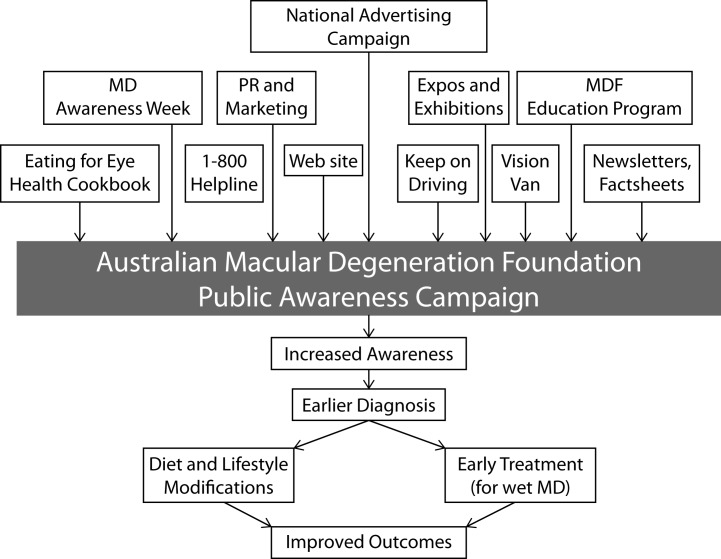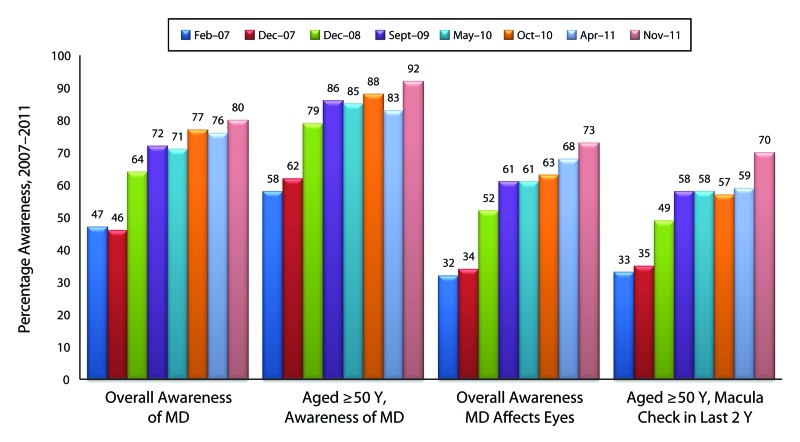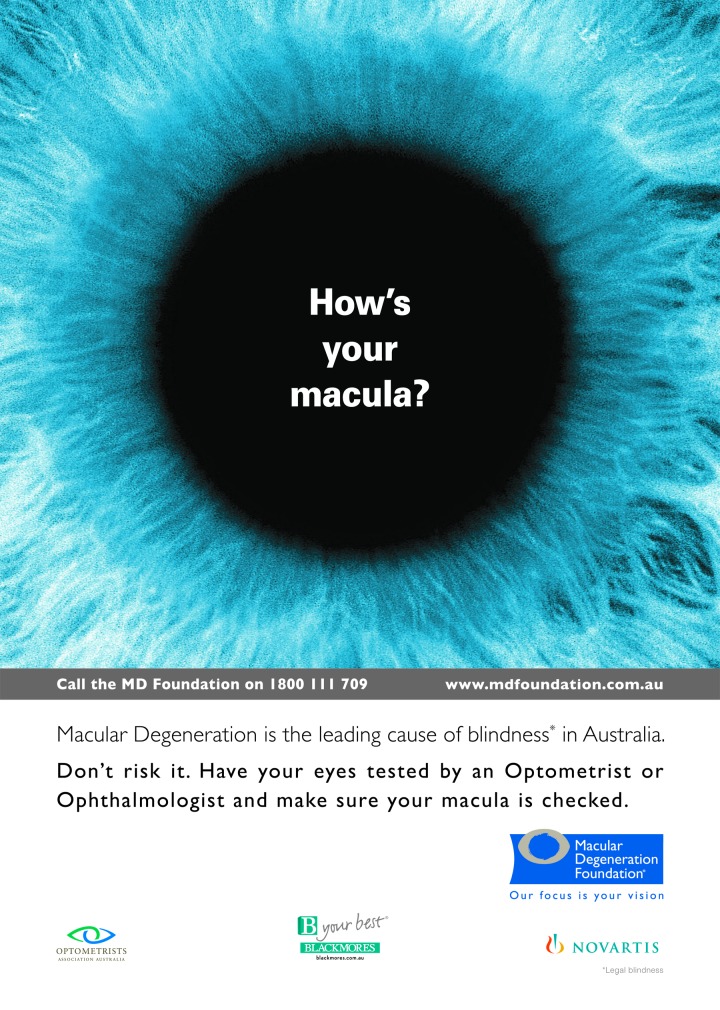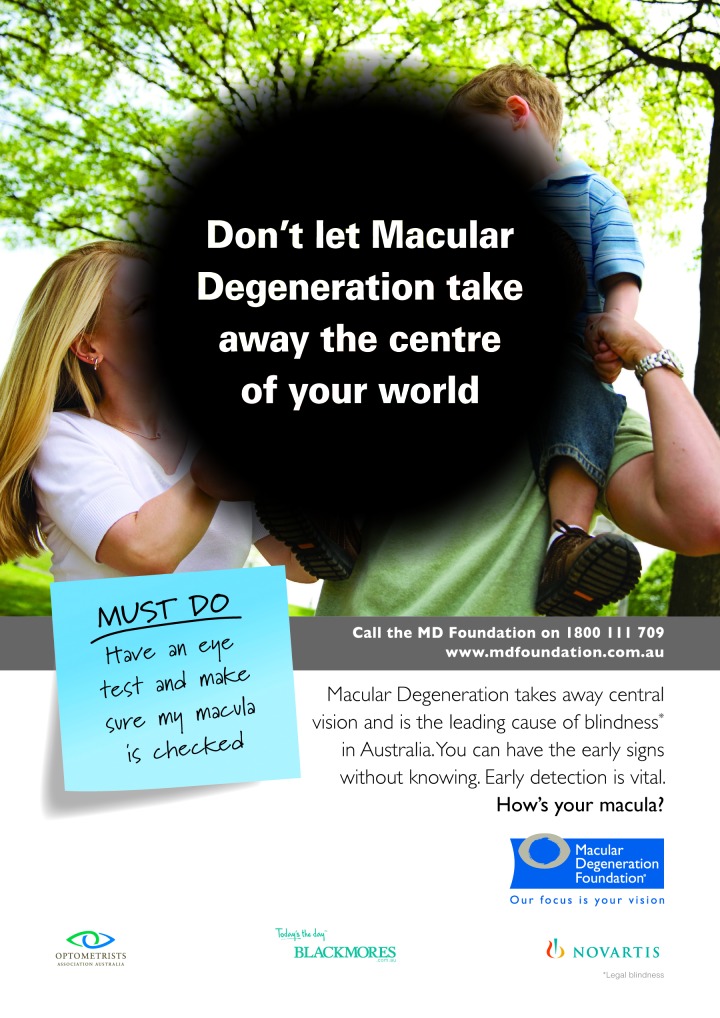Abstract
Between 2007 and 2011, the Australian Macular Degeneration Foundation conducted a multifaceted campaign to increase public awareness of macular degeneration. Regular national polls conducted by an independent social research company have shown that awareness of macular degeneration increased from 47% to 80% in Australians aged 16 years or older and from 58% to 92% in those aged 50 years or older. The percentage of people aged 50 years or older who reported having had their macula checked in the 2 years prior to the survey increased from 33% to 70% from 2007 to 2011. Other measures, including analysis of Medicare data, have confirmed the success of the campaign.
KEY FINDINGS
▪Between 2007 and 2011, the Australian Macular Degeneration Foundation substantially increased the scope of its multilayered disease awareness activities and included several waves of a mass media advertising campaign.
▪Awareness of macular degeneration and the numbers of people requesting a check of their macula have dramatically increased from 2007 to 2011, as measured by regular, independent national polls and other measures.
MACULAR DEGENERATION IS the leading cause of blindness and severe vision loss in developed countries, including Australia. Macular degeneration is primarily age related, and 1 in 7 Australians older than 50 years is affected in some way.1 The macular degeneration landscape has changed dramatically in the last decade:
Treatment of “wet” (neovascular) macular degeneration has improved radically with the introduction of anti-VEGF (vascular endothelial growth factor) treatments, with potential to preserve and, in many cases, improve vision.2,3
The recent discovery of specific genes associated with macular degeneration4 has highlighted the need for community understanding of the major role of genetics in the development of macular degeneration and the need for those affected to inform family of their increased risk.
The importance of lifestyle modifications (especially smoking cessation, the major modifiable risk factor) and diet in reducing risk and slowing disease progression is better understood.1
A LAYERED APPROACH TO INCREASE AWARENESS
The Macular Degeneration Foundation, a charity established in 2001, is the national macular degeneration peak body in Australia. Increasing community awareness of macular degeneration is a major focus of the foundation, to promote early detection for those at risk (see box on the next page). When a diverse range of activities (Figure 1) was used, a “layering effect” resulted in significant improvements in macular degeneration awareness in Australia (Figure 2). We describe these activities in the following subsections.
FIGURE 1—
Australian Macular Degeneration Foundation (MDF) model showing relation between awareness-raising activities and improved outcomes: February 2007–November 2011.
Note. MD = macular degeneration; PR = public relations.
FIGURE 2—
Macular degeneration (MD) awareness rates in Australian population throughout period of awareness campaign: February 2007–November 2011.
Source. National poll conducted by Galaxy Research on behalf of the Macular Degeneration Foundation.
Education Programs
The Macular Degeneration Foundation provides a nationwide toll-free help line and a Web site providing patients, their families, and caregivers with current, practical, and evidence-based information on risk reduction and disease management. A range of educational publications, available in hard copy or for download from the foundation's Web site (http://www.mdfoundation.com.au), provides support in prevention, diagnosis, treatment, and rehabilitation. Key resources are available in 6 languages. Funding has been obtained recently to produce all of our materials in audio format.
WHY IS INCREASED AWARENESS AND EARLY DIAGNOSIS OF MACULAR DEGENERATION SO IMPORTANT?
Early diagnosis allows earlier modification of diet and lifestyle (including smoking cessation) to reduce risk and slow disease progression.1
Awareness increases testing of family members who are at much greater risk for disease.1
Early diagnosis enables regular self-testing with an Amsler grid for early detection of vision changes, including possible progression to “wet” (neovascular) disease. The Amsler grid also helps detect unilateral changes that might otherwise be missed until the second eye is affected.
Early diagnosis of neovascular disease enables treatment of smaller lesions, improving outcomes.5
Face-to-face education sessions reaching urban, regional, and remote and diverse ethnic communities across Australia reinforce key health messages and increase recognition, prevention, and treatment of maculardegeneration. Interpreters are used when appropriate.
Foundation educators regularly exhibit and present at national ophthalmology, optometry, and pharmacy congresses. In addition, printed resources are made available to health care practices free of charge.
General practitioners can play an important role in early detection of macular degeneration, referral, and conveying key preventive health messages. A pilot professional development program for general practitioners, accredited at the highest level by the Royal Australian College of General Practice, was successfully conducted by the Macular Degeneration Foundation in 2009; funding is being sought to fully implement this program. The foundation's education program cost approximately AU $500 000 (excluding salaries) in 2009 to 2010.
National Advertising Campaign
Following baseline measurements of community awareness of macular degeneration in 2007 showing that only 46% of Australians were aware of macular degeneration, the foundation mounted a national television, radio, and print advertising campaign (http://www.mdfoundation.com.au/News_National_Awareness_Advertising_Campaign.aspx) that targeted the main at-risk group (aged ≥ 50 years) in 7 waves over 4 years. The campaign's call to action was to “Have your eyes tested” and “Make sure the macula is checked” and referred people to the foundation's help line for free information and ongoing support (see box on the next page). The campaign did not relate to any macular degeneration treatments. The AU $2 million annual cost of the campaign was funded by Novartis Australia.
The Macular Degeneration Foundation commissioned a series of national telephone surveys throughout the campaign period (February 2007–November 2011). For each survey, a stratified random sample of 1100 people from the White Pages telephone directory (http://www.whitepages.com.au)was used. Across the period during which the campaign was conducted, awareness of macular degeneration increased substantially (Figure 2). In particular:
In people aged 16 years or older, awareness increased from 47% to 80% (with a maximum margin of error of 2.9%).
In the at-risk group (aged 50 years or older), awareness increased from 58% to 92%.
Understanding that macular degeneration is a disease affecting the eyes increased from 32% to 73%.
The percentage of people aged 50 years or older who reported having their macula checked in the 2 years prior to the survey increased from 33% to 70%.
In the most recent poll, 59% of people reported that they became aware of macular degeneration from television or radio advertising.
MACULAR DEGENERATION FOUNDATION KEY MESSAGES
Schedule regular eye checks.
Consume “eye-friendly” diet (increased oily fish, leafy green vegetables, nuts, low glycemic index foods).
Stop smoking.
Maintain a healthy weight and do regular exercise.
Use sun protection (sunglasses and hat).
Use an Amsler grid.
Seek professional help immediately if any sudden vision changes occur.
Encourage eye checks in family members.
These messages are consistent with broader health messages from government and other health-related nongovernment organizations.
In addition to the surveys of the general public, optometrists were invited via their association's newsletter to complete an online precampaign and postcampaign questionnaire. Approximately 200 optometrists completed each survey (sampling error of ±5% at 95% confidence level). From February 2007 to April 2011, there was a 287% increase in reported patient requests for macula checks and an average of 12 additional established patients and 5 new patients each week for appointments.
Macular Degeneration Awareness Week promotional poster for 2010.
Macular Degeneration Awareness Week promotional poster for 2011.
Medicare claims data6 showed an average 5.6% annual increase in all new patient consultations for optometrists since the campaign began, compared with an average 3.8% annual increase in the 4 years before the campaign.
The success of the advertising campaign was also reflected in the 41% increase in calls to the Macular Degeneration Foundation's help line from 2007 to 2011 and in the 90% increase in visits to the foundation's Web site. The help line now takes an average of 60 calls per day from the public, and the Web site has more than 250 000 discreet visits per year.
Macular Degeneration Awareness Week
Macular Degeneration Awareness Week is firmly established in the Australian health calendar and generates significant media coverage. The potential audience reach increased from 3 million in 2006 to more than 30 million in 2011. To garner support for awareness activities from the wider community, each year more than 12 000 Macular Degeneration Awareness Week information kits have been sent to ophthalmologists, optometrists, orthoptists, libraries, community centers, pharmacies, health food stores, and parliamentarians for distribution. The campaign's theme, “How's your macula?,” has been used in all promotional and media material. The secondary message of “Don't let macular degeneration take away the centre of your world” was used in 2011 to improve understanding that macular degeneration affects central vision.
Vision Van Screening Unit
A mobile screening unit (the “Vision Van”) provided free macular degeneration testing to people aged 50 years or older in regional and remote areas of Australia. The initiative was a collaboration among Novartis Australia, Optometrist Association Australia, and the Royal Australian and New Zealand College of Ophthalmologists. Following 3 tours, Vision Van optometrists screened 3607 people, and signs of macular degeneration were detected in approximately 12% of those older than 50 years, closely matching known prevalence. Significant local media were generated.
Macular Degeneration Cookbook
Eating for Eye Health, The Macular Degeneration Cookbook, provided a platform for the promotion of key health messages through diet and lifestyle. Eating for Eye Health received widespread media attention, and more than 7000 copies have now been sold through the Macular Degeneration Foundation.
Keep on Driving Safely Campaign
From January 2009, brochures were distributed with more than 5 million driver's license renewal forms in New South Wales, the Australian state with the largest population. The brochure encourages an eye test and macula check, with a tear-off card to request a Macular Degeneration Foundation information kit. Approximately 400 information requests per month resulted from the “Keep on Driving Safely” campaign.
CONCLUSIONS
A focused 4-year campaign building on layers of multifaceted work has resulted in dramatically increased awareness of macular degeneration in Australia. More patients are receiving information to reduce the risk of the disease and facilitate early detection. Many others who have already lost sight are obtaining practical support to help maintain independence and quality of life. The investment in raising awareness of macular degeneration has had a multiplier effect in increasing the early diagnosis of other eye diseases and promoting allied key health messages targeted by the Australian Commonwealth Government, including smoking cessation, reducing obesity, and improving diet.
Acknowledgments
Funding for the mass media awareness campaign was provided by Novartis Australia. For Macular Degeneration Awareness Week, financial support was provided by Novartis Australia, Blackmores, and NSW Health. In-kind support was provided by Optometrists Association Australia, bluedesk, and Porter Novelli. Additional funding was provided by the Australian government.
Human Participant Protection
Human participation was limited to Galaxy Polls (surveys) measuring disease awareness. No institutional review board approval was required for these surveys.
References
- 1.Deloitte Access Economics. Eyes on the Future: A Clear Outlook on Age-Related Macular Degeneration. Report prepared for the Macular Degeneration Foundation. October 2011. Available at: http://www.mdfoundation.com.au/LatestNews/MDFoundationDeloitteAccessEconomicsReport2011.pdf. Accessed November 1, 2011.
- 2.Brown DM, Michels M, Kaiser PK, Heier JS, Sy JP, Ianchulev T. Ranibizumab versus verteporfin photodynamic therapy for neovascular age-related macular degeneration: two-year results of the ANCHOR study. Ophthalmology. 2009;116(1):57–65. [DOI] [PubMed] [Google Scholar]
- 3.Rosenfeld PJ, Brown DM, Heier JSet al. Ranibizumab for neovascular age-related macular degeneration. N Engl J Med. 2006;355(14):1419–1431. [DOI] [PubMed] [Google Scholar]
- 4.Hageman GS, Anderson DH, Johnson LVet al. A common haplotype in the complement regulatory gene factor H (HF1/CFH) predisposes individuals to age-related macular degeneration. Proc Natl Acad Sci U S A. 2005;102(20):7227–7232. [DOI] [PMC free article] [PubMed] [Google Scholar]
- 5.Mitchell P, Korobelnik JF, Lanzetta Pet al. Ranibizumab (Lucentis) in neovascular age-related macular degeneration: evidence from clinical trials. Br J Ophthalmol. 2010;94(1):2–13. [DOI] [PubMed] [Google Scholar]
- 6.Medicare Australia. Medicare Item Reports (items 10900 to 10918). Available at: https://www.medicareaustralia.gov.au/statistics/mbs_item.shtml. Accessed November 1, 2011.






